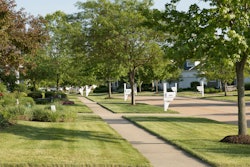
If your clients are dealing with discoloration or even areas of the turf that appear to be dying, they could have a lawn fungus problem brewing. Humidity and excessive rainfall can lead to lawn fungus growth and wreak havoc on your clients’ lawns. But making a proper diagnosis and implementing a solution will help get their lawn back on track.
Diagnosing lawn disease
Identifying the turf disease that your client’s lawn is struggling with is an important first step. Many of these diseases can be swift-moving and highly destructive as they go. In general, some of the common signs of a lawn disease problem include symptoms like lesions on the grass blades, irregularly shaped patches on the lawn, webby substances on the lawn, or powdery substances on the lawn.
While there are many different lawn diseases, two of the most frequently seen right now are Brown Patch and Dollar Spot. While these two diseases can be difficult to tell apart, looking at the individual grass blades can help you distinguish one from another.
Brown Patch disease
As the name implies, Brown Patch causes patches of brown discoloration throughout the lawn. These are caused by the moisture-loving fungus Rhizoctonia Solani. Brown Patch can start out small, but it also spreads rapidly.
Since this is similar to Dollar Spot, which we’ll describe next, you need to look close-up at the lesions. When you look at the individual blades of grass, Brown Patch will present as blotchy lesions. Dollar Spot has lesions that travel laterally across leaf blades. A brown border often surrounds each of the lesions.
Dollar Spot disease
Dollar Spot has very similar characteristics and to your clients might just look like patches of brown areas across the lawn. But Dollar Spot gets its name because when it first appears on the lawn it starts as small circles that resemble the size and shape of silver dollars. Soon, the individual patches grow together and look a lot like the irregular patches caused by Brown Patch disease.
However, if you look closely at the lesions, you’ll be able to distinguish these two diseases and make a proper diagnosis for your client.
Next steps for lawn disease
You have options when it comes to treating your clients’ lawn for disease. Fungicides can suppress the spread of these disease and can make a valuable add-on service. But they are also an expensive investment, and some clients won’t want to pay for what could be as much as twice or three times a normal application.
Therefore, making appropriate cultural recommendations might also make sense. In most cases, lawn fungus runs its course without causing too much damage. Teaching clients how to properly water the lawn so that they are not exacerbating any issues is important. Clients should not be watering the lawn in late afternoon or evening, when the sun does not have enough time to evaporate excess water.
You might also talk to clients about any standing water or drainage issues that could be leading to fungal growth. A service like aeration and overseeding can also help restore any areas that were damage by lawn fungus. You can also use this time to introduce more disease-resistant grass types into the lawn so that it will better stand up to lawn fungus in the future.











